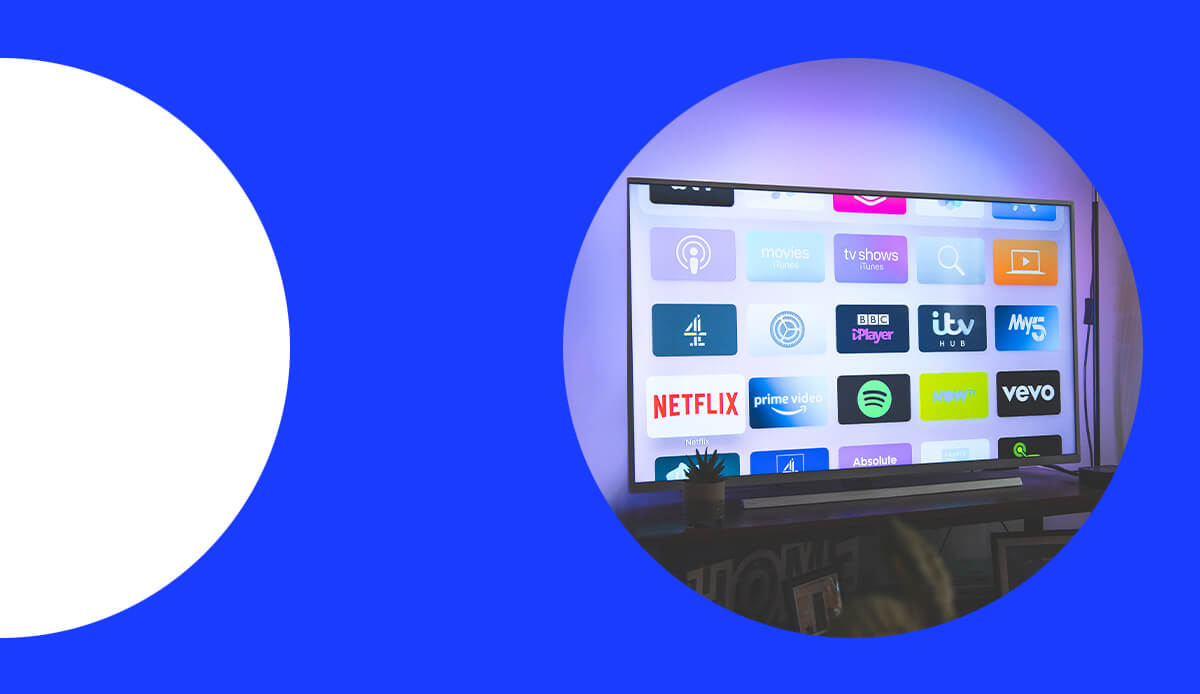Programmatic TV: The Marketer’s Guide to Real Time Bidding in the Streaming Ecosystem

Discover how the real-time bidding capabilities of programmatic TV advertising create a level playing field for everyone
Since its mainstream adoption in the 1950s, television has remained a dominant force in consumer advertising. As TV tech has evolved to add color, cable networks, and internet connectivity, advertising has kept pace right alongside it. Even with the advent of computers, smartphones, and other sources of entertainment, TV still commands the highest and most consistent levels of ad attention across marketing channels.
But as costs for linear TV continue to rise and shut all but the most prominent players out of its ecosystem. More and more marketers are now turning to programmatic TV advertising, where ad prices aren’t determined by who you know. Instead, real-time bidding (RTB) provides access to a massive content network. You’ll also get insight into who is watching and converting with your ads. Performance marketing tools grant the ability to squeeze every last drop out of your marketing budget. Programmatic TV advertising puts the power of television within anyone’s grasp. Read on to learn how it can work for you.
What is programmatic TV advertising?
Programmatic TV advertising is a method of performance marketing that leverages internet-connected streaming TV options. Programmatic allows advertisers to optimize campaign messaging, audience targeting, and other KPIs through automated ad creative delivery.
How ad delivery works:
1. A viewer turns on their smart TV (or a streaming device connected to a standard TV) and starts up a free, ad-supported television service packed with content to watch.
2. As the viewer watches their favorite TV show, the channel makes ad requests to a supply-side platform (SSP). The SSP manages the ad inventory on the channel and sets prices based on supply and demand.
3. The SSP communicates with a demand-side platform (DSP). Advertisers work with DSPs through private or public marketplaces. Here, marketers can set their target audience, content, and other parameters, along with the maximum price they’re willing to pay for ad placement. DSPs also provide real-time reporting to advertisers allowing them to manage their campaign performance and adjust accordingly.
4. DSPs and SSPs begin automated rounds of real-time bidding as advertisers attempt to win the ad spot based on their maximum bid value.
5. The highest bid wins the ad spot, and the SSP delivers the ad to the viewer.
To the viewer, this entire process is invisible and nearly instantaneous. It’s a boon for marketers though. This is so because it provides unprecedented insight and control into TV ad campaigns that marketers never had before. They can target ads with precision to specific demographics based on several factors, including viewing history, household size, age, salary range, and even ZIP code. Plus, pricing is open and transparent, based on supply and demand instead of backroom negotiations — programmatic TV is truly an advertising equalizer.
Download The Definitive Guide to Programmatic Streaming TV for more information on the programmatic TV advertising landscape and to gain expert insight on how to ensure your ad campaign is a success.
The rise of programmatic advertising on TV
The growth of programmatic TV advertising largely coincides with the advent of streaming TV, leveraging similar concepts that have been in use since the introduction of internet banner ads in the 1990s. These programmatic ads provided relevant content to users based on browsing habits and have since evolved and expanded into social media, and mobile games, as well as streaming video and television.
Meanwhile, linear TV continues to hold much of the attention of marketing departments. As audience habits shift toward streaming options and marketers become more aware of programmatic TV advertising’s benefits, this is starting to change.
While linear TV may command large viewing audiences, it’s largely a black box for marketers — money and content go in, and results come out, but there’s no concrete way to track a direct, causal relationship between them. Because of this lack of information, updating creative during a campaign to capitalize on ad response is virtually impossible.
Compared to the hands-off, opaque nature of linear TV, the benefits of programmatic TV are immediately clear. Marketers that know how to harness its power can see immediate and direct results of their ad buys. Plus, advertisers can easily A/B test creative and pivot mid-campaign based on the data.
92% of US households are reachable via streaming TV, and that number continues to grow as more viewers use streaming apps to supplement — or replace — linear TV viewing. As audience attention turns to streaming options for entertainment, so too should advertisers shift their budgets to leverage this unique growth opportunity.
Programmatic vs direct deals
There are a couple of ways to access streaming TV ad inventory: programmatic TV spots available through private or public marketplaces and direct deals with publishers. Both options have their strengths, and both are viable ways to get your ad seen by many of the 142 million U.S. adults who watch streaming TV each week.
Programmatic TV
- Access to a curated and diverse slate of inventory
- Auctions generate prices based on supply and demand
- Advertising is not limited to a specific publisher or channel
- Ability to make creative adjustments allows for A/B testing and optimizations mid-campaign
- Reporting updated in real-time while a campaign is active
- Best for most advertisers
Direct Deals
- Access to premium inventory
- Prices negotiated on a deal-by-deal basis
- Advertising is limited to the publisher with which the agreement is made
- Creative adjustments are usually not allowed
- Reporting provided after the end of the campaign
- Best for global organizations with established relationships
Programmatic TV advertising agencies like M+C Saatchi Performance are a great opportunity for advertisers of all sizes — from streaming TV newcomers, challenger brands like start-ups and small businesses, to mainstream brands and performance marketing experts. With vetted, brand-safe inventory and full access to campaign performance data, we’ll make sure you’ve got the tools you need to maximize your reach across the streaming TV ecosystem.
Get started with programmatic TV advertising today
Programmatic marketplaces make advertising on television more accessible than ever, and advertisers who have added streaming TV to their media mix have seen stellar KPIs that are hard to ignore.
If you’re looking to dip your toes into the streaming waters for the first time, download our free ebook, The Definitive Guide to Programmatic Streaming TV for Performance Marketing. We partnered with experts at Roku, Samsung Ads, AppsFlyer, and tvScientific to deliver critical insights into delivering a successful campaign that reaches — and converts — your target audience. Download the guide today, and maximize the ROAS on your next streaming TV ad campaign.

